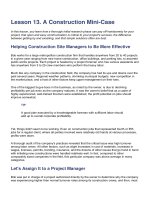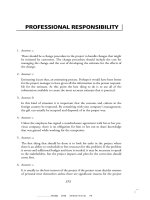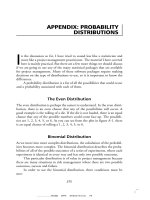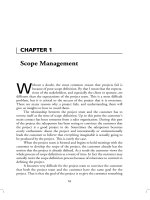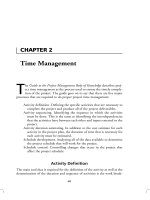Project management IS
Bạn đang xem bản rút gọn của tài liệu. Xem và tải ngay bản đầy đủ của tài liệu tại đây (16.86 MB, 265 trang )
Project Management
© Adrienne Watt
This work is licensed under a Creative Commons-ShareAlike 4.0 International License
Original source: The Saylor Foundation
/>7d826be&contributor=&keyword=&subject=
Contents
Introduction ...................................................................................................................1
Preface ............................................................................................................................2
About the Book ..............................................................................................................3
Chapter 1 Project Management: Past and Present ....................................................5
1.1 Careers Using Project Management Skills ......................................................................5
1.2 Business Owners ...............................................................................................................5
Example: Restaurant Owner/Manager ..........................................................................6
1.2.1 Outsourcing Services ..............................................................................................7
Example: Construction Managers ..........................................................................8
1.3 Creative Services ................................................................................................................9
Example: Graphic Artists ...............................................................................................10
1.4 Educators ..........................................................................................................................10
Example: Teachers .........................................................................................................11
1.5 Engineers ..........................................................................................................................11
1.6 Health Care........................................................................................................................12
Example: Radiology Technologists ..............................................................................13
Example: Nurses ............................................................................................................14
1.7 Paralegal ...........................................................................................................................14
1.8 Software developer .........................................................................................................15
1.9 Science Technicians .........................................................................................................15
1.10 History..............................................................................................................................16
1.11 Attribution ......................................................................................................................19
Chapter 2 Project Management Overview ................................................................20
2.1 Project Attributes .............................................................................................................20
2.2 Definition of a Project .....................................................................................................21
2.3 Project Characteristics ....................................................................................................21
2.4 The Process of Project Management .............................................................................22
2.5 Project Management Expertise.......................................................................................28
2.6 Application knowledge.....................................................................................................28
2.7 Understanding the Project Environment.......................................................................29
2.8 Management Knowledge and Skills ..............................................................................31
2.9 Interpersonal Skills ...........................................................................................................32
2.9.1 Communication .....................................................................................................32
2.9.2 Influence ................................................................................................................33
2.9.3 Leadership .............................................................................................................33
2.9.4 Motivation .............................................................................................................34
2.9.5 Negotiation ............................................................................................................34
2.9.6 Problem Solving ....................................................................................................34
2.10 Attribution ......................................................................................................................35
Chapter 3 The Project Life Cycle (Phases) .................................................................36
3.1 Initiation Phase ................................................................................................................36
3.2 Planning Phase ................................................................................................................36
3.3 Implementation (Execution) Phase ...............................................................................37
3.4 Closing Phase ...................................................................................................................38
Example: Project Phases on a Large Multinational Project ......................................39
3.5 Attribution ........................................................................................................................40
Chapter 4 Framework for Project Management ......................................................41
4.1 Project Management Institute Overview ......................................................................41
4.2 So what is PMBOK?...........................................................................................................42
4.3 Introduction to the Project Management Knowledge Areas ......................................44
4.3.1 Project Start-Up and Integration ........................................................................45
4.3.2 Project Scope ........................................................................................................45
4.3.3 Project Schedule and Time Management .........................................................47
4.3.4 Project Costs .........................................................................................................48
4.3.5 Project Quality ......................................................................................................49
4.3.6 Project Team: Human Resources and Communications .................................50
4.3.7 Communications ..................................................................................................51
4.3.8 Project Risk ............................................................................................................52
4.3.9 Project Procurement ............................................................................................53
4.3.10 Project Stakeholder Management ....................................................................54
4.3.11 Scrum Development Overview .........................................................................54
4.3.12 The Project Management Office .......................................................................56
4.4 Attribution ........................................................................................................................57
Chapter 5 Stakeholder Management .........................................................................58
5.1 Project Stakeholders .......................................................................................................59
5.1.1 Top Management ..................................................................................................59
5.1.2 The Project Team ..................................................................................................60
5.1.3 Your Manager .......................................................................................................60
5.1.4 Peers ......................................................................................................................61
5.1.5 Resource Managers .............................................................................................61
5.1.6 Internal Customers ..............................................................................................62
5.1.7 External customer ................................................................................................62
5.1.8 Government ..........................................................................................................62
5.1.9 Contractors, subcontractors, and suppliers ......................................................63
5.2 Politics of Projects ...........................................................................................................63
5.3 Assess the environment .................................................................................................64
5.3.1 Identify goals .........................................................................................................64
5.3.2 Define the problem ..............................................................................................64
5.3.3 Culture of Stakeholders........................................................................................64
Example: Culture Affects Communication in Mumbai ......................................65
Example: Cultural Differences between American Regions .............................65
5.3.4 Managing Stakeholders ........................................................................................65
Example: Tire Plant in India ..................................................................................66
Example: Stakeholders and a Bridge Project .....................................................67
5.4 Relationship Building Tips ..............................................................................................67
5.5 How to Relate to Different Types of Stakeholders ......................................................68
5.6 Supportive Stakeholders are Essential to Project Success .........................................69
5.7 Tools to Help Stakeholder Management .......................................................................69
5.8 Attribution ........................................................................................................................71
Chapter 6 Culture and Project Management ............................................................72
6.1 What Is Organizational Culture? ....................................................................................72
6.2 Project Manager’s Checklist ...........................................................................................72
6.3 Project Team Challenges ................................................................................................73
6.4 Dealing with Conflict .......................................................................................................74
6.5 References ........................................................................................................................74
6.6 Attribution ........................................................................................................................75
Chapter 7 Project Initiation .........................................................................................76
7.1 Comparing Options Using a Weighted Decision Matrix .............................................82
7.2 Weighted Decision Matrix Sample .................................................................................82
7.3 Financial Considerations..................................................................................................83
7.4 NPV .....................................................................................................................................84
7.5 NPV Example ....................................................................................................................86
7.6 ROI .....................................................................................................................................87
7.7 Payback Period .................................................................................................................87
7.8 Project Charter .................................................................................................................88
7.8.1 Purpose of the Project Charter ...........................................................................88
7.8.2 Simple example of project charter......................................................................89
7.8.2.1 Identification Section .................................................................................89
Example: .........................................................................................................89
7.8.2.2 Overview of the Project .............................................................................89
Example ..........................................................................................................89
7.8.2.3 Objective .....................................................................................................89
Example ..........................................................................................................90
7.8.2.4 Scope ...........................................................................................................90
Example ..........................................................................................................90
Example ..........................................................................................................90
7.8.2.5 Major Milestones........................................................................................90
Example ..........................................................................................................90
7.8.2.6 Major Deliverables .....................................................................................91
Example ..........................................................................................................91
7.8.2.7 Assumptions ...............................................................................................91
Example ..........................................................................................................91
7.8.2.8 Constraints..................................................................................................91
Example: .........................................................................................................92
7.8.2.9 Business Need or Opportunity (Benefits) ...............................................92
Example: .........................................................................................................92
7.8.2.10 Preliminary Cost for the Project .............................................................92
Example: .........................................................................................................92
7.8.2.11 Project Risks..............................................................................................92
Example: .........................................................................................................93
7.8.2.12 Project Charter Acceptance ...................................................................93
7.8.2.13 Project Stakeholders................................................................................93
7.9 Attribution ........................................................................................................................93
Chapter 8 Overview of Project Planning ....................................................................94
Example 1 ...............................................................................................................................95
Example 2 ...............................................................................................................................95
8.1 Attribution ........................................................................................................................96
Chapter 9 Scope Planning ...........................................................................................97
9.1 Defining the Scope ..........................................................................................................97
9.2 Project Requirements .....................................................................................................98
9.3 Functional Requirements ................................................................................................98
Vehicle Example .............................................................................................................98
Computer System Example ..........................................................................................99
9.4 Non-Functional Requirements .......................................................................................99
9.5 Technical Requirements .............................................................................................. 100
9.6 Business Requirements ............................................................................................... 100
9.7 User Requirements ...................................................................................................... 100
9.8 Regulatory requirements ............................................................................................. 101
9.9 An Example of Requirements ...................................................................................... 101
9.10 Software Requirements Fundamentals ................................................................... 102
9.11 Measuring Requirements ........................................................................................... 103
9.12 Scope Inputs ................................................................................................................ 104
9.13 Techniques .................................................................................................................. 105
9.14 Requirements Traceability Matrix ............................................................................ 105
9.15 Matrix Fields ................................................................................................................ 106
9.16 Work Breakdown Structure ....................................................................................... 107
9.17 Overview ...................................................................................................................... 107
9.18 Example of a WBS........................................................................................................ 108
9.19 Scope Statement ........................................................................................................ 111
9.20 Attribution ................................................................................................................... 112
Chapter 10 Project Schedule Planning ....................................................................113
10.1 Defining Activities ....................................................................................................... 113
10.2 A Case Study ................................................................................................................ 113
10.2.1 WBS Exercise (Solution follows)...................................................................... 115
10.2.2 Activity List ........................................................................................................ 116
10.2.3 External Predecessors .................................................................................... 119
10.2.4 Discretionary Predecessors ........................................................................... 119
10.2.5 Mandatory Predecessors ............................................................................... 119
10.2.6 Leads and Lags ................................................................................................. 119
10.2.7 Milestones ......................................................................................................... 121
10.2.8 The Activity Sequencing Process .................................................................... 122
10.3 Creating the Gantt Chart ............................................................................................ 123
10.4 Creating the Network Diagram.................................................................................. 124
10.5 The Critical Path........................................................................................................... 127
10.6 Attribution ................................................................................................................... 129
Chapter 11 Resource Planning .................................................................................130
11.1 Estimating the Resources .......................................................................................... 130
11.2 Estimating Activity Durations .................................................................................... 131
11.3 Project Schedule and Critical Path ............................................................................ 133
11.4 Resource Management .............................................................................................. 136
11.5 HR Planning ................................................................................................................. 137
11.6 Managing the Team ................................................................................................... 137
11.7 Techniques for Managing Resources ....................................................................... 138
11.8 Resource Leveling ....................................................................................................... 138
11.9 Working with Individuals ........................................................................................... 139
11.10 Emotional Intelligence ............................................................................................. 139
11.11 Personality Types ..................................................................................................... 139
11.12 Leadership Styles ..................................................................................................... 141
Example: Multinational Textbook Publishing Project ............................................. 143
11.13 Leadership Skills ....................................................................................................... 143
11.14 Listening ..................................................................................................................... 144
Example: Client’s Body Language ............................................................................. 145
11.15 Negotiation ............................................................................................................... 146
11.16 Conflict Resolution .................................................................................................... 147
Example: Resolving an Office Space Conflict ........................................................... 148
Example: Conflict Over a Change Order .................................................................. 149
11.17 Delegation ................................................................................................................. 149
Example: Learning Project in Peru ............................................................................ 151
11.18 Adjusting Leadership Styles .................................................................................... 151
11.19 Working with Groups and Teams ........................................................................... 152
11.19.1 Trust ................................................................................................................ 152
11.19.2 Contracts and Trust Relationships .............................................................. 152
11.19.3 Types of Trust ................................................................................................ 153
11.19.4 Creating Trust ................................................................................................ 153
Example: High Cost of Lying in a Charleston Project ..................................... 154
11.19.5 Managing Team Meetings ............................................................................ 154
11.20 Action Item Meetings ............................................................................................... 155
11.21 Management Meetings ............................................................................................ 155
11.22 Leadership Meetings ............................................................................................... 157
11.23 Types of Teams ......................................................................................................... 158
11.23.1 Functional Teams .......................................................................................... 158
11.23.2 Cross-Functional Teams ............................................................................... 159
Example: Cross-Functional Teamwork ............................................................. 159
11.23.3 Problem-Solving Teams ................................................................................ 159
11.24 Qualitative Assessment of Project Performance .................................................. 159
Example: Humm Survey Uncovers Concerns .......................................................... 161
11.25 Creating a Project Culture ....................................................................................... 162
11.25.1 Characteristics of Project Culture ................................................................ 162
Example: Operational Rules on a Multi-site Project ....................................... 163
Example: Creating a Culture of Collaboration ................................................. 163
11.26 Innovation on Projects ............................................................................................. 164
Example: Stress Managed on a Website Design Project ........................................ 164
11.27 References ................................................................................................................. 165
11.28 Attribution ................................................................................................................. 165
Chapter 12 Budget Planning .....................................................................................166
12.1 Estimating Costs to Compare and Select Projects ................................................. 167
12.2 Analogous Estimate .................................................................................................... 167
Example: Analogous Estimate for John’s Move ....................................................... 168
12.3 Parametric Estimate.................................................................................................... 168
Example: Parametric Estimate for John’s Move ...................................................... 168
12.4 Bottom-Up Estimating ................................................................................................ 169
Example: Bottom-Up Estimate for John’s Move ...................................................... 169
12.5 Activity-Based Estimates............................................................................................. 170
12.6 Managing the Budget ................................................................................................. 172
12.6.1 Managing Cash Flow ....................................................................................... 172
12.6.2 Contingency Reserves ..................................................................................... 172
12.6.3 Management Reserves ................................................................................... 173
12.6.4 Evaluating the Budget During the Project .................................................... 173
Example: Reporting Budget Progress on John’s Move ................................... 173
12.6.5 Earned Value Analysis...................................................................................... 174
Example: Planned Value on Day Six of John’s Move ....................................... 174
Example: Comparing PV, EV, and AC in John’s Move on Day Six ................... 175
12.6.6 Schedule Variance ............................................................................................ 175
Example: Schedule Variance on John’s Move .................................................. 177
Example: Cost Variance on John’s Move .......................................................... 178
Example: Cost Performance Index of John’s Move ......................................... 178
12.6.7 Estimated Cost to Complete the Project ...................................................... 179
Example: Estimate to Complete John’s Move .................................................. 180
12.6.8 Estimate Final Project Cost.............................................................................. 180
Example: Estimate at Completion for John’s Move ......................................... 180
12.6.9 Establishing a Budget ..................................................................................... 182
12.6.10 Budget Timeline ............................................................................................. 182
12.7 Attribution ................................................................................................................... 183
Chapter 13 Procurement Management ..................................................................184
13.1 Make-or-Buy Analysis ................................................................................................. 185
13.2 Contract Types ............................................................................................................. 185
13.2.1 Fixed-Price Contracts ....................................................................................... 185
13.2.2 Cost-Reimbursable Contracts ......................................................................... 187
13.3 Progress Payments and Change Management ...................................................... 190
13.4 Procurement Process ................................................................................................. 191
13.4.1 Procurement Plan ........................................................................................... 191
13.4.2 Selecting the Contract Approach ................................................................... 192
13.4.3 Soliciting Bids ................................................................................................... 192
13.4.4 Qualifying Bidders ........................................................................................... 192
13.4.5 Request for Quote ........................................................................................... 193
13.4.6 Request for Proposal ...................................................................................... 193
13.4.7 Evaluating Bids ................................................................................................ 194
13.4.8 Awarding the Contract .................................................................................... 194
13.4.9 Managing the Contracts .................................................................................. 194
13.4.10 Logistics and Expediting ............................................................................... 195
13.5 Attribution ................................................................................................................... 196
Chapter 14 Quality Planning .....................................................................................197
14.1 Quality and Grade ....................................................................................................... 198
Example: Quality of Gasoline Grades ....................................................................... 198
Example: Quality of Furniture Packing ..................................................................... 199
14.2 Statistics........................................................................................................................ 199
Example: Setting Control Limits ................................................................................ 200
Example: Normal Distribution ................................................................................... 201
Example: Standard Deviation of Gasoline Samples ............................................... 202
Example: Gasoline Within Three Standard Deviations .......................................... 203
Example: A Step Project Improves Quality of Gasoline .......................................... 204
14.3 Quality planning tools ................................................................................................ 205
Example: Tolerance in Gasoline Production ............................................................ 205
14.4 Defining and Meeting Client Expectations .............................................................. 205
14.5 Sources of Planning Information .............................................................................. 206
14.6 Techniques ................................................................................................................... 206
Example: Diagramming Quality Problems ............................................................... 207
14.7 Quality Assurance ....................................................................................................... 209
14.8 Process Analysis ......................................................................................................... 209
Example: Analyzing Quality Processes in Safety Training ...................................... 210
14.9 Attribution ................................................................................................................... 210
Chapter 15 Communication Planning .....................................................................211
15.1 Types of Communication ........................................................................................... 212
15.2 Synchronous Communications ................................................................................. 212
15.3 Remember Time Zones .............................................................................................. 213
Example: Conference Call between Toronto and Paris .......................................... 213
15.4 Asynchronous Communications .............................................................................. 214
15.4.1 Mail and Package Delivery ............................................................................. 214
15.4.2 Fax ..................................................................................................................... 214
15.4.3 Email ................................................................................................................. 215
15.4.4 Project Blog ...................................................................................................... 215
15.4.5 Really Simple Syndication (RSS) ..................................................................... 215
15.5 Assessing New Communication Technologies ....................................................... 216
15.6 Communication Plan Template ................................................................................. 216
15.7 Attribution ................................................................................................................... 217
Chapter 16 Risk Management Planning ...................................................................218
16.1 Risk Management Process ........................................................................................ 219
16.2 Risk Identification ........................................................................................................ 220
Example: Risks in John’s Move ................................................................................... 220
16.3 Risk Evaluation............................................................................................................. 221
Example: Risk Analysis of Equipment Delivery ....................................................... 223
16.4 Risk Mitigation ............................................................................................................ 224
16.5 Contingency Plan ........................................................................................................ 225
16.6 Project Risk by Phases ............................................................................................... 226
16.6.1 Initiation ............................................................................................................ 226
Example: Risks by Phase in John’s Move .......................................................... 227
16.6.2 Planning Phase ................................................................................................. 228
Example: Risk Breakdown Structure for John’s Move .................................... 228
16.6.3 Implementation Phase ................................................................................... 229
16.6.4 Closeout Phase ................................................................................................. 229
Example: Risk Closeout on John’s Move ........................................................... 230
16.7 References ................................................................................................................... 230
16.8 Attribution ................................................................................................................... 230
Chapter 17 Project Implementation Overview ......................................................232
17.1 Change Control ........................................................................................................... 233
17.2 Attribution ................................................................................................................... 234
Chapter 18 Project Completion ................................................................................235
18.1 Contract Closure ......................................................................................................... 235
18.2 Releasing the Project Team ....................................................................................... 236
18.3 Final Payments ............................................................................................................ 237
18.4 Post-Project Evaluations ............................................................................................ 237
18.5 Trust and Alignment Effectiveness ........................................................................... 238
18.6 Schedule and Budget Management ......................................................................... 238
18.7 Risk Mitigation ............................................................................................................ 238
18.8 Procurement Contracts ............................................................................................. 238
18.9 Customer Satisfaction ................................................................................................ 239
18.10 Senior Management ................................................................................................ 239
18.11 Archiving of Document ............................................................................................ 239
18.12 Attribution ................................................................................................................. 240
Chapter 19 Celebrate!.................................................................................................241
19.1 Attribution ................................................................................................................... 242
Appendix 1: Project Management PowerPoints......................................................243
Appendix 2: Chapter Questions ................................................................................245
Chapter 5: Project Management Overview....................................................................... 245
Chapter 6: The Project Life Cycle (Phases)........................................................................ 245
Chapter 8: Stakeholder Management ............................................................................... 246
Chapter 10: Project Initiation ............................................................................................. 246
Chapter 12: Scope Planning ............................................................................................... 247
Chapter 13: Project Schedule Planning ............................................................................. 247
Chapter 15: Budget Planning ............................................................................................. 249
Chapter 16: Procurement Management ........................................................................... 250
Chapter 17: Quality Planning.............................................................................................. 251
Chapter 19: Risk Management Planning........................................................................... 251
Appendix 3: Chapter Audio Files ...............................................................................253
About the Author .......................................................................................................255
1
Introduction
Available under Creative Commons-ShareAlike 4.0 International License (http://creativecommon
s.org/licenses/by-sa/4.0/).
People have been undertaking projects since the earliest days of organized human
activity. The hunting parties of our prehistoric ancestors were projects. Large complex
projects such as the pyramids and the Great Wall of China were also projects. Even
something as simple as creating a dinner is considered a project. We use the term
“project” frequently in our daily conversations. This book covers the basics of project
management. This includes the process of initiation, planning, execution, control, and
closeout that all projects share.
2
Preface
Available under Creative Commons-ShareAlike 4.0 International License (http://creativecommon
s.org/licenses/by-sa/4.0/).
The primary purpose of this text is to provide an open source textbook that covers
most project management courses. The material in the textbook was obtained from a
variety of sources. All the sources are found in the reference section at the end of
each chapter. I expect, with time, the book will grow with more information and more
examples.
I welcome any feedback that would improve the book. If you would like to add a
section to the book, please let me know.
3
About the Book
Available under Creative Commons-ShareAlike 4.0 International License (http://creativecommon
s.org/licenses/by-sa/4.0/).
Project Management is a remix and adaptation. The adaptation is a part of the
BCcampus Open Textbook project .
The B.C. Open Textbook Project began in 2012 with the goal of making post-secondary
education in British Columbia more accessible by reducing student cost through the
use of openly licensed textbooks. The BC Open Textbook Project is administered by
BCcampus and funded by the British Columbia Ministry of Advanced Education.
Open textbooks are open educational resources (OER); they are instructional
resources created and shared in ways so that more people have access to them. This
is a different model than traditionally copyrighted materials. OER are defined as
teaching, learning, and research resources that reside in the public domain or have
been released under an intellectual property license that permits their free use and
re-purposing by others (Hewlett Foundation). Our open textbooks are openly licensed
using a Creative Commons license, and are offered in various e-book formats free of
charge, or as printed books that are available at cost. For more information about this
project, please contact If you are an instructor who is using
this book for a course, please let us know.
Project Management by Adrienne Watt is a remix of the following works:
100 Percent Rule by Pabipedia licensed under Creative Commons AttributionShareAlike 3.0 License
Communication Plans by Inte6160 Wiki licensed under Creative Commons Attribution
3.0 Unported.
Decision Matrix Method and Project Charter by Wikipedia the Free Encyclopedia
licensed under Creative Commons Alike Attribution 3.0 Unported.
Gantt chart by Wikipedia licensed under Creative Commons Attribution-ShareAlike 3.0
Unported
How to Build Relationships with Stakeholders By Erin Palmer licensed under Creative
Commons Attribution 3.0 Unported
Planning a Project by OpenLearn Labspace under Creative Commons Attribution 3.0
Unported.
Project Decelerators – Lack of Stakeholder Support By Jose Solera licensed under
Creative Commons Attribution
3.0 Unported Project Management by Merrie Barron and Andrew Barron licensed
under Creative Commons Attribution 3.0 Unported
Project Management for Instructional Designers by Amado, M., Ashton, K., Ashton, S.,
Bostwick, J., Clements, G., Drysdale, J., Francis, J., Harrison, B., Nan, V., Nisse, A.,
Randall, D., Rino, J., Robinson, J., Snyder, A., Wiley, D., & Anonymous. (DATE). Project
4
Management for Instructional Designers. Retrieved from under
Creative Commons Attribution 3.0 Unported.
Project Management for Skills for All Careers by Project Management Open Resources
and TAP-a-PM licensed under Creative Commons Attribution 3.0 Unported.
Project Management from Simple to Complex by Russel Darnall, John Preston, Eastern
Michigan University licensed under Creative Commons Attribution 3.0 Unported.
Project Management/PMBOK/Human Resources Management and Development
Cooperation Handbook/How do we manage the human resources of programmes
and projects?/Manage the Project Team by Wikibooks licensed under Creative
Commons Attribution-Share Alike 3.0,
Project Management/PMBOK/Scope Management and Development Cooperation
Handbook/Designing and Executing Projects/Detailed Planning or design stage by
Wikibooks licensed under Creative Commons Attribution 3.0 Unported.
Resource Management and Resource Leveling by Wikipedia licensed under Creative
Commons Attribution-Share Alike 3.0 License. Work Breakdown Structure by
Wikipedia licensed under Creative Commons Attribution-ShareAlike 3.0 License
5
Chapter 1 Project Management: Past
and Present
Available under Creative Commons-ShareAlike 4.0 International License (http://creativecommon
s.org/licenses/by-sa/4.0/).
Adrienne Watt
1.1 Careers Using Project Management Skills
Available under Creative Commons-ShareAlike 4.0 International License (http://creativecommon
s.org/licenses/by-sa/4.0/).
Skills learned by your exposure to studying project management can be used in most
careers as well as in your daily life. Strong planning skills, good communication, ability
to implement a project to deliver the product or service while also monitoring for risks
and managing the resources will provide an edge toward your success. Project
managers can be seen in many industry sectors including agriculture and natural
resources; arts, media, and entertainment; building trades and construction; energy
and utilities; engineering and design; fashion and interiors; finance and business;
health and human services; hospitality, tourism, and recreation; manufacturing and
product development; public and private education services; public services; retail and
wholesale trade; transportation; and information technology.
Below we explore various careers and some of the ways in which project management
knowledge can be leveraged.
1.2 Business Owners
Available under Creative Commons-ShareAlike 4.0 International License (http://creativecommon
s.org/licenses/by-sa/4.0/).
Business owners definitely need to have some project management skills. With all
successful businesses, the product or service being delivered to the customer meets
their needs in many ways. The product or service is of the quality desired, the costs
are aligned with what the consumer expected, and the timeliness of the product or
service meets the deadline for the buyer of that item.
The pillars of project management are delivering a product/service within schedule,
cost, scope, and quality requirements. Business owners need planning, organizing,
and scoping skills and the ability to analyze, communicate, budget, staff, equip,
implement, and deliver.
Understanding the finances, operations, and expenses of the business are among the
skills that project managers learn and practice. Some businesses may focus more on
accounting, providing financial advice, sales, training, public relations, and actuary or
logistician roles. Business owners may own a travel agency or provide hospitality.
6
Business owners could be managing a storefront or a location in their town’s
marketplace.
Example: Restaurant Owner/Manager
Restaurant managers are responsible for the daily operations of a
restaurant that prepares and serves meals and beverages to
customers. Strong planning skills, especially coordinating with the
various departments (kitchen, dining room, banquet operations, food
service managers, vendors providing the supplies) ensure that
customers are satisfied with their dining experience. Managers’
abilities to recruit and retain employees, and monitor employee
performance and training ensure quality with cost containment.
Scheduling in many aspects, not only the staff but also the timing of
the food service deliveries, is critical in meeting customer
expectations.
Risk management is essential to ensure food safety and quality.
Managers monitor orders in the kitchen to determine where delays
may occur, and they work with the chef to prevent these delays. Legal
compliance is essential in order for the restaurant to stay open, so
restaurant managers direct the cleaning of the dining areas and the
washing of tableware, kitchen utensils, and equipment. They ensure
the safety standards and legality, especially in serving alcohol.
Sensitivity and strong communication skills are needed when
customers have complaints or employees feel pressured because
more customers arrive than predicted.
Financial knowledge is needed for the soundness of running the
restaurant, especially tracking special projects, events, and costs for
the various menu selections. Catering events smoothly can be an
outcome of using project plans and the philosophy of project
management. The restaurant manager or the executive chef analyzes
the recipes to determine food, labor, and overhead costs; determines
the portion size and nutritional content of each serving; and assigns
prices to various menu items, so that supplies can be ordered and
received in time.
Planning is the key for successful implementation. Managers or
executive chefs need to estimate food needs, place orders with
distributors, and schedule the delivery of fresh food and supplies.
They also plan for routine services (equipment maintenance, pest
control, waste removal) and deliveries, including linen services or the
heavy cleaning of dining rooms or kitchen equipment, to occur
during slow times or when the dining room is closed. A successful
restaurant relies on many skills that the project management
profession emphasizes.
7
1.2.1 Outsourcing Services
Available under Creative Commons-ShareAlike 4.0 International License (http://creativecommon
s.org/licenses/by-sa/4.0/).
Figure 1.1 Sample status chart, which is typical with the use of a red-yellow-green, by Maura Irene
Jones in Project Management Skills for All Careers
Sample status chart, which is typical with the use of a red-yellow-green, by Maura
Irene Jones in Project Management Skills for All Careers ( oc
t/Textbooks/ProjectManagementforAllCareersEdition2.pdf, https://creativecommons.o
rg/licenses/by/3.0/ ) .
Many businesses explore outsourcing for certain services. Below is a sample status
and project plan that reflects the various tasks needed for a project. A review of
finances, the importance of communicating to stakeholders, and the importance of
time, cost, schedule, scope, and quality are reflected. Many companies may use these
steps in their business. These plans show the need for the entire team to review the
various proposals to choose the best plan. Figure 1.1 Sample status chart, which is typi
cal with the use of a red-yellow-green, by Maura Irene Jones in Project Management Sk
ills for All Careers represents a sample project status report.
8
Example: Construction Managers
Construction managers plan, direct, coordinate, and budget a wide
variety of residential, commercial, and industrial construction
projects including homes, stores, offices, roads, bridges, wastewater
treatment plants, schools, and hospitals. Strong scheduling skills are
essential for this role. Communication skills are often used in
coordinating design and construction processes, teams executing the
work, and governance of special trades (carpentry, plumbing,
electrical wiring) as well as government representatives for the
permit processes. A construction manager may be called a project
manager or project engineer. The construction manager ensures that
the project is completed on time and within budget while meeting
quality specifications and codes and maintaining a safe work
environment. These managers create project plans in which they
divide all required construction site activi-ties into logical steps,
estimating and budgeting the time required to meet established
deadlines, usually utilizing sophisticated scheduling and costestimating software. Many use software packages such as Microsoft
Project® or Procure® or online tools like BaseCamp®. Most
construction projects rely on spreadsheets for project management.
Procurement skills used in this field include acquiring the bills for
material, lumber for the house being built, and more. Construction
managers also coordinate labor, determining the needs and
overseeing their performance, ensuring that all work is completed on
schedule.
Values including sustainability, reuse, LEED-certified building, use of
green energy, and various energy efficiencies are being incorporated
into today’s projects with an eye to the future. Jennifer Russell, spoke
about project management and global sustainability” at the 2011
Silicon Valley Project Management Institute (PMI) conference. She
informed the attendees of the financial, environmental, and social
areas in expanding the vision of project management with the slide
in Figure 1.2 Project Management by Jennifer Russell . These values
are part of the PMI’s code of ethics and professionalism. By adhering
to this code, project managers include in their decisions the best
interests of society, the safety of the public, and enhancement of the
environment.
9
Figure 1.2 Project Management by Jennifer Russell
Project Management by Jennifer Russell ( https://c
reativecommons.org/licenses/by/3.0/ ) . Creative Commons 4.0 International License
( />
1.3 Creative Services
Available under Creative Commons-ShareAlike 4.0 International License (http://creativecommon
s.org/licenses/by-sa/4.0/).
Creative service careers include graphic artists, curators, video editors, gaming
managers, multimedia artists, media producers, technical writers, interpreters, and
translators. These positions use project management skills, especially in handling the
delivery channel and meeting clients’ requirements.
Let us look at one example, graphic artists, to understand and identify some of the
project management skills that aid in this career.
10
Example: Graphic Artists
Graphic artists plan, analyze, and create visual solutions to
communication problems. They use many skills found in project
management, especially communications. They work to achieve the
most effective way to get messages across in print and electronic
media. They emphasize their messages using color, type, illustration,
photography, animation, and various print and layout techniques.
Results can be seen in magazines, newspapers, journals, corporate
reports, and other publications. Other deliverables from graphic
artists using project management skills include promotional
displays, packaging, and marketing brochures supporting products
and services, logos, and signage. In addition to print media, graphic
artists create materials for the web, TV, movies, and mobile device
apps.
Initiation in project management can be seen in developing a new
design: determining the needs of the client, the message the design
should portray, and its appeal to customers or users. Graphic
designers consider cognitive, cultural, physical, and social factors in
planning and executing designs for the target audience, very similar
to some of the dynamics a project manager considers in
communicating with various project stakeholders. Designers may
gather relevant information by meeting with clients, creative staff, or
art directors; brainstorming with others within their firm or
professional association; and performing their own research to
ensure that their results have high quality and they can manage
risks.
Graphic designers may supervise assistants who follow instructions
to complete parts of the design process. Therefore scheduling,
resource planning, and cost monitoring are pillars of project
management seen in this industry. These artists use computer and
communications equipment to meet their clients’ needs and business
requirements in a timely and cost-efficient manner.
1.4 Educators
Available under Creative Commons-ShareAlike 4.0 International License (http://creativecommon
s.org/licenses/by-sa/4.0/).
“Educator” is a broad term that can describe a career in teaching, maybe being a
lecturer, a professor, a tutor, or a homeschooler. Other educators include gurus,
mullahs, pastors, rabbis, and priests. Instructors also provide vocational training or
teach skills like learning how to drive a car or use a computer. Educators provide
motivation to learn a new language or showcase new products and services.
Educators use project management skills including planning and communication.
11
Let us look at teachers, since we all have had teachers, and see if we can recognize the
project management skills that are demonstrated in this profession.
Example: Teachers
Some teachers foster the intellectual and social development of
children during their formative years; other teachers provide
knowledge, career skill sets, and guidance to adults. Project
management skills that teachers exhibit include acting as facilitators
or coaches and communicating in the classroom and in individual
instruction. Project managers plan and evaluate various aspects of a
project; teachers plan, evaluate, and assign lessons; implement these
plans; and monitor each student’s progress similar to the way a
project manager monitors and delivers goods or services. Teachers
use their people skills to manage students, parents, and
administrators. The soft skills that project managers exercise can be
seen in teachers who encourage collaboration in solving problems by
having students work in groups to discuss and solve problems as a
team.
Project managers may work in a variety of fields with a broad
assortment of people, similar to teachers who work with students
from varied ethnic, racial, and religious backgrounds. These teachers
must have awareness and understanding of different cultures.
Teachers in some schools may be involved in making decisions
regarding the budget, personnel, textbooks, curriculum design, and
teaching methods, demonstrating skills that a project manager would
possess such as financial management and decision making.
1.5 Engineers
Available under Creative Commons-ShareAlike 4.0 International License (http://creativecommon
s.org/licenses/by-sa/4.0/).
Engineers apply the principles of science and mathematics to develop economical
solutions to technical problems. As a project cycles from an idea in the project charter
to the implementation and delivery of a product or service, engineers link scientific
discoveries to commercial applications that meet societal and consumer needs.
Engineers use many project management skills, especially when they must specify
functional requirements. They demonstrate attention to quality as they evaluate a
design’s overall effectiveness, cost, reliability, and safety similar to the project
manager reviewing the criteria for the customer’s acceptance of delivery of the
product or service.
Estimation skills in project management are used in engineering. Engineers are asked
many times to provide an estimate of time and cost required to complete projects.
12
1.6 Health Care
Available under Creative Commons-ShareAlike 4.0 International License (http://creativecommon
s.org/licenses/by-sa/4.0/).
There are many jobs and careers in health care that use project management skills.
Occupations in the field of health care vary widely, such as athletic trainer, dental
hygienist, massage therapist, occupational therapist, optometrist, nurse, physician,
physician assistant, and X-ray technician. These individuals actively apply risk
management in providing health care delivery of service to their clients, ensuring that
they do not injure the person they are caring for. Note: There is a section on nursing
later in this chapter.
Many of you may have had a fall while you were growing up, and needed an X-ray to
determine if you had a fracture or merely a sprain. Let us look at this career as an
example of a health care professional using project management skills.
13
Example: Radiology Technologists
Radiology technologists and technicians perform diagnostic imaging
examinations like X-rays, computed tomography (CT), magnetic
resonance imaging (MRI), and mammography. They could also be
called radiographers, because they produce X-ray films (radiographs)
of parts of the human body for use in diagnosing medical problems.
Project management skills, especially people skills and strong
communication, are demonstrated when they prepare patients for
radiologic examinations by explaining the procedure and what
position the patient needs to be in, so that the parts of the body can
be appropriately radio graphed. Risk management is demonstrated
when these professionals work to prevent unnecessary exposure to
radiation by surrounding the exposed area with radiation protection
devices, such as lead shields, or limiting the size of the X-ray beam.
To ensure quality results, the health technician monitors the
radiograph and sets controls on the X-ray machine to produce
radiographs of the appropriate density, detail, and contrast.
Safety and regulations concerning the use of radiation to protect
themselves, their patients, and their coworkers from unnecessary
exposure is tracked in an efficient manner and reported as a control
to ensure compliance. Project management skills are also used in
preparing work schedules, evaluating equipment for purchase, or
managing a radiology department.
Some radiological technologists specialize in CT scans; as CT
technologists they too use project management skills. CT uses
ionizing radiation to produce a substantial number of cross-sectional
X-rays of an area of the body. Therefore, it requires the same
precautionary measures that are used with X-rays, hence the need for
risk management and monitoring for exposure.
Teamwork, not only with the patient that the radiological
technologist supports and the doctor who ordered the request, but
also with other health care providers, relies on strong
communication, quality, work done in a timely manner, and wise use
of hospital resources. This all boils down to ensuring that the three
elements of the project management triangle of cost, schedule, and
scope with quality delivered remain the essentials that provide a
cornerstone to project management and the skills needed to obtain
the objective.
14
Example: Nurses
Nurses treat and educate patients and their families and the public
about various medical conditions and provide advice and emotional
support. Nurses establish a care plan for their patients that include
activities like scheduling the administration and discontinuation of
medications (e.g., intravenous (IV) lines for fluid, medication, blood,
and blood products) and application of therapies and treatments.
Communication with the patient, their family, physicians and other
health care clinicians may be done in person or via technology.
Telehealth allows nurses to provide care and advice through
electronic communications media including videoconferencing, the
Internet, or telephone.
Risk management is very important for a nurse, with some cases
having a life or death consequence. Nurses monitor pain
management and vital signs and provide status reports to physicians
to help in responding to the health care needs of the patient.
The nursing field varies. Some nurses work in infection control. They
identify, track, and control infectious outbreaks in health care
facilities and create programs for outbreak prevention and response
to biological terrorism. Others are educators who plan, develop,
execute, and evaluate educational programs and curricula for the
professional development of students and graduate nurses. Nurses
may use project management skills while conducting health care
consultations, advising on public policy, researching in the field, or
providing sales support of a product or service.
1.7 Paralegal
Available under Creative Commons-ShareAlike 4.0 International License (http://creativecommon
s.org/licenses/by-sa/4.0/).
Attorneys assume the ultimate responsibility for legal work but they often obtain
assistance. Paralegals assume this role in law firms and perform many tasks to aid the
legal profession. However, they are explicitly prohibited from carrying out duties
considered to be the practice of law (e.g., giving legal advice, setting legal fees,
presenting court cases).
Project management skills such as planning are used in helping lawyers prepare for
closings, hearings, trials, and corporate meetings. Communication skills are used in
preparing written reports that help attorneys determine how cases should be handled
or drafts for actions such as pleading, filing motions, and obtaining affidavits.
Monitoring skills aid paralegals who may track files of important case documents,
working on risk containment related to filing dates and responses to the court.
Procurement skills, which a project manager uses, can also be seen from a paralegal
15
perspective in negotiating terms of hiring expert witnesses as well as other services
such as acquiring services from process servers.
Financial skills may be used as well, such as assisting in preparing tax returns,
establishing trust funds, and planning estates or maintaining financial office records at
the law firm.
Government, litigation, personal injury, corporate law, criminal law, employee
benefits, intellectual property, labor law, bankruptcy, immigration, family law, and real
estate are some of the many different law practices where a paralegal professional
may use project management skills.
1.8 Software developer
Available under Creative Commons-ShareAlike 4.0 International License (http://creativecommon
s.org/licenses/by-sa/4.0/).
Computer software developers and computer programmers design and develop
software. They apply the principles of computer science and mathematics to create,
test, and evaluate software applications and systems that make computers come
alive. Software is developed in many kinds of projects: computer games, business
applications, operating systems, network control systems, and more. Software
developers us project management skills to develop the requirements for the
software, identify and track the product development tasks, communicate within the
development team and with clients, test cases, and manage quality, the schedule, and
resources (staff, equipment, labs, and more).
1.9 Science Technicians
Available under Creative Commons-ShareAlike 4.0 International License (http://creativecommon
s.org/licenses/by-sa/4.0/).
Science technicians use principles and theories of science and mathematics to assist in
research and development and help invent and improve products and processes. In
their jobs, they are more practically oriented than scientists. Planning skills project
managers use can be seen as science technicians set up, operate, and maintain
laboratory instruments; monitor experiments; and observe, calculate, and record
results. Quality is a factor here as it is in project management; science technicians
must ensure that processes are performed correctly, with proper proportions of
ingredients, for purity or for strength and durability.
There are different fields in which science technicians can apply project management
skills. Agricultural and food science technicians test food and other agricultural
products and are involved in food, fiber, and animal research, production, and
processing. Control and risk management are important here in executing the tests
and experiments, for example, to improve the yield and quality of crops, or the
resistance of plants and animals to disease, insects, or other hazards. Quality factors
are paramount when food science technicians conduct tests on food additives and
preservatives to ensure compliance with government regulations regarding color,
texture, and nutrients.


